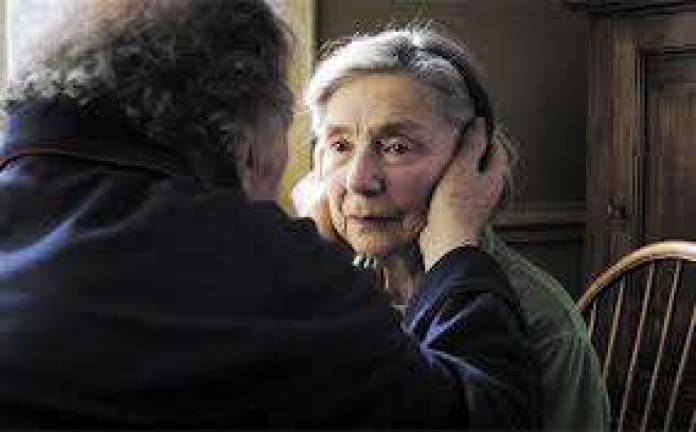Amour: Enduring Love in Any Language

A series of unwanted guests creep into the orbit of Anne and George, a married couple of retired music teachers now in their 80s. There's the criminal who tries to break into their handsomely lived-in Paris apartment early in Amour, Michael Haneke's superlative mature new film. And there's that pesky bird that keeps flying in the window George leaves wide open. But the biggest offender would have to be Anne's own body, which begins to revolt against itself, causing the degeneration of both her own dignity as well as her loving relationship to George. There's no escaping it ? Amour is a tough movie, made all the more exacting than other Haneke films Funny Games and The White Ribbon by its quiet stillness. Stemming from a purported personal brush with loss, his film examines true love and companionship. Anne enters a fugue state during a seemingly normal breakfast (aren't they always, until something out of the ordinary happens?) with George. The cause is deemed an obstructed carotid artery, but a successful surgery yields devastating side effects. Anne loses function in the right half of her body, which shows no signs of ever recovering. George must tend Anne's needs, which include dressing, feeding and bathing. Eventually, Anne's weakening body infects her spirit as well, and she retreats within herself emotionally. Amour's approach is nothing but honest, as are the brave performances of Emmanuelle Riva and Jean-Louis Trintignant as Anne and George. There isn't a hint of artifice to these two, who rank among French film royalty. Trintignant gradually reveals the corrosive effect his caretaking takes on him; several scenes with George dealing with a mentally recessive Anne are devastating, but never false. Riva, too, is a one-woman discourse on performance at its purest and most comfortable. Her work is heavenly. Haneke's choices are also too spare to ever feel manipulative. He never explains, for example, during the recurring presence of their estranged daughter, Eva (Isabelle Huppert, excellent and essential), just why the relationship between parent and child has grown cold ? and yet evidence is visible throughout his very specific movie. It may be depressing to many, but the overall message is clarion clear: decay is a necessary, inevitable denouement to all relationships. If Amour were merely a sophisticated look at love and loss, it would be a fine picture, but not a masterpiece. What makes Amour the truly transcendent movie that it is ? and it is, easily, the best movie of the year ? is the subtly cunning visual acuity with which Haneke tells his harrowing tale. Much of the film's important action, including doctors' visits and surgeries, are only described, not witnessed. Almost every scene occurs within the confines of the couple's apartment, which becomes a character unto itself (production designer Jean-Vincent Puzos and set decorator Susanne Haneke have done work as crucial to the film as the choice to cast the impeccable Riva and Trintignant). Cinematographer Darius Khondji, shooting in 1.85:1, adds invaluable perspective to every scene, using perspective to show Anne's fraying grip on her vitality and, more importantly, George's shifting frame of mind. (The slow physical decline of the apartment also, of course, mirrors the subtle deterioration of Anne and George's relationship.) Playwrights should take note of Haneke's methods. How often do people remark of the impossibility of adapting a work from the stage for the celluloid? Amour exists largely within the world of an apartment, but never feels stagy or confined. Where a director like, say, Roman Polanski would exploit the setting for claustrophobic causes, Haneke succeeds in gifting his mise-en- scène with psychological heft, peeling back layers of character information without feeling the need to highlight for viewers. Of course, Haneke does follow in the footsteps of storied directors varying from Edwin S. Porter to Bob Fosse to Francis Ford Coppola in his choice to implicate his audience within Anne and George's situation. In an early scene that does step outside of the apartment, Haneke positions his two leads, still in good health, in the audience of a pupil's concert. It puts the audience on the same footing as his characters; the watchers become the watched. And it forces us to become active empathizers to the sad ballad of Anne and George. How would we react in their situation? What choices would we make? Most of all, could this really happen to us and our loved ones as well? Visually, viscerally, Haneke's Amour is a stupendous film about the forms love can take that we try not to think about. And it asserts that from every loss, something far deeper will always be gained.